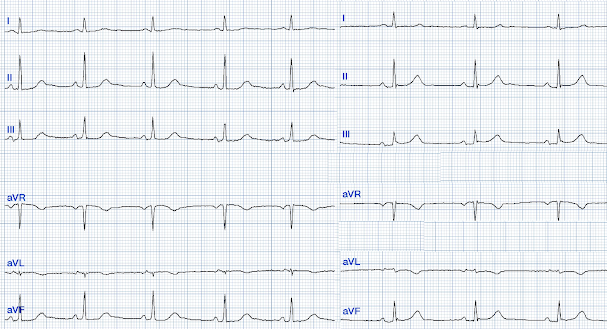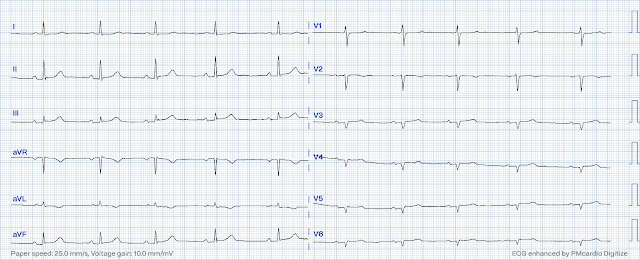Written by Magnus Nossen MD, peer reviewed and edits by Smith, Meyers, Grauer
A 60 something previously healthy female smoker sought medical attention after 2-3 days of intermittent chest discomfort. The chest discomfort was described as sharp. Episodes lasting 5-30 minutes. On the day of presentation she experienced another episode of chest discomfort accompanied by vomiting and throat pain. She was concerned about possible throat infection. She contacted her primary care physician. Due to the vague nature of her symptoms and the fact that she had chest discomfort and no clinical sign of throat infection she was referred for further work up.
Upon admission she had ongoing slight chest discomfort. Vital signs unremarkable except borderline hypotension with a systolic BP about 102 mmHg. The following ECG was recorded.
Here the image quality is enhanced using the PM Cardio app. What do you think?
The presenting ECG shows SR with narrow QRS complexes. There is normal R-wave progression in the precordial leads with no evidence of ischemia. In the limb leads there is T-wave inversion in lead aVL with a low amplitude QRS preceding the T-wave. There is some upwards concave ST segment elevation in the inferior leads with what seems to be well formed J-waves.
First troponin I returned 3174 ng/l, at which point a repeat ECG was ordered.
 |
| Not much difference from 1st ECG. |
A bedside echo was performed.
The bedside echocardiography showed a dilated and hypokinetic RV with an internal diameter (RVIDd) at the base about 4,0cm. The RV > LV. There is visible septal flattening with D-sign in the parasternal short axis. McConnells sign was present. (maybe not seen well on these echo-loops) The CW doppler at the tricuspid valve showed a maximum TR velocity of 2,55m/s with a TRP gradient of 26mmHg.
Possible explanations for the echocardiographic findings could be grouped accordingly:
- 1) Conditions causing volume overload of the RV. (E.g large ASD, partial anomalous pulmonary venous return, significant tricuspid regurgitation, carcinoid valvular disease, etc,)
- 2) Conditions causing pressure overload of the RV. (Any cause of pulmonary hypertension. E.g COPD, Idiopathic PAH, acute or chronic PE, pulmonary valve stenosis, etc)
- 3) Conditions affecting RV myocardial contractility, such as ARVD or RV infarction
The ECGs does not really show any signs of chronic RV dilation or hypertrophy. There is normal axis, normal R-wave progression in the precordial leads and no intraventricular conduction abnormalities. Furthermore there are no ST-T changes in the early precordial leads as could be expected if the dilation was caused by pulmonary embolus or ARVD.
At this point an old ECG on file was found for comparison.
Below, the limb leads of the baseline ECG (left) placed side-by-side with the limb leads of the presentation ECG (right).
When placed side by side, the hyperacuity of the inferior T waves can be appreciated. It is also now easier to appreciate that the more bulky T wave inversion in aVL must represent reciprocal change from inferior wall hyperacute T waves. Also, looking through the retrospectoscope, the isoelectric ST segment in lead V2 on the presentation ECG becomes quite suspect for posterior wall involvement.
Baseline limb leads Presentation limb leads
Notice the T-waves in II, III, and aVF are substantially larger
On their own, this would not be diagnostic, but highly suspicious.
Just the fact of chest pain and highly elevated troponin is enough to activate the cath lab, but here you can see just how subtle hyperacute T-waves can be.
Based on the ECG changes, the echocardiographic findings, troponin level and rapid onset of symptoms the clinical picture seemed best explained by some acute process, making pulmonary embolus or acute MI most likely. An acute RCA OMI with inferior and right ventricular involvement fits way better than PE in this case, there really was no respiratory symptoms and O2 saturations and other vital signs were unremarkable, a right sided ECG was recorded and is shown below.
The right sided ECG shows lack of any real R-wave in V3R-V6R. Also there is subtle but proportionally significant ST elevation in the same leads. The limb leads also seem to show some progression of inferior OMI findings. The cath lab was activated and the patient was found to have a 100% proximal RCA occlusion with TIMI 0 flow. Post PCI the patient became gravely hypotensive and "shocky". She stabilized on dobutamine and levosimendan infusions that could be discontinued after 24 hours. Troponin T peaked at 2074 ng/L (very high, typical of OMI/STEMI). The tricuspid annular plane systolic excursion (TAPSE) improved from 15mm to 19mm within the first 24 hours. The LV EF was 57% at formal echo.
This case represents an RCA occlusion with inferior wall OMI findings on the ECG and echocardiographically predominant RV involvement.
Purely isolated RV infarction is limited to patients with a dominant Cx or to patients who already have had an inferior wall MI who then later experience a proximal RCA occlusion. Isolated RV infarct will not show inferior wall OMI findings. RV infarction usually have ST-elevation or OMI findings in the right precordial leads overlying the right ventricle.
This is the ECG at discharge 3 days post PCI.
Learning points:
1) OMI can be very subtle and RV infarction may manifest poorly on the standard ECG.
2) Typical persistent chest pain with a sigificantly elevated troponin is OMI until proven otherwise, regardless of the ECG.
3) RV Failure leads to hypotension but NOT pulmonary edema (unlike LV failure)
4) Repeat ECGs, right sided ECG and bedside echo may be helpful in making a diagnosis of ACS.
5) McConnells sign can be seen in both RV infarction and acute RV pressure overload as with large PE
Here is a great case of Right Ventricular MI with both D sign and McConnell's sign:
===================================
MY Comment, by KEN GRAUER, MD (9/17/2023):
===================================
I love cases when an unexpected outcome is so logically arrived at. Our THANKS to Dr. Magnus Nossen for sharing this case with us.
- I focus my comment on the initial ECG in today's case — which I've reproduced in Figure-1, and to which I've added the previous tracing found on file.
-USE.png) |
| Figure-1: Comparison between today's initial ECG — and the baseline ECG that was on file. (To improve visualization — I've digitized the original ECG using PMcardio). |
My Thoughts on the Initial ECG in Figure-1:
Key points in the history of today's patient — is that her symptoms of CP (Chest Pain) were intermittent over a 2-3 day period — without specific mention of when during this time period symptoms were greatest. As a result — the onset of any acute event that may have occurred is uncertain. In view of this history — I found ECG #1 of concern because of the following findings:
- There is ST elevation in each of the 3 inferior leads. Although the amount of ST elevation is not great in ECG #1, and there is J-point notching as commonly occurs with repolarization variants — the ST segment prior to the T waves in these inferior leads is straightened.
- Lead aVL is definitely not normal. Although the tiny QRS amplitude in this lead makes assessment difficult — the J-point in lead aVL is depressed, the ST segment in this lead is abnormally coved — and the T wave relative to QRS amplitude is hypervoluminous and markedly disproportionate. The shape of this ST-T wave in lead aVL is a reduced-size mirror-image opposite picture of the ST-T wave in lead III — which in a patient with CP, could clearly reflect reciprocal changes of a recent or ongoing acute process.
- In support of that these findings in lead aVL are not normal — the other high-lateral lead ( = lead I) is also not normal in appearance (ie, the ST segment in lead I is completely flat — in association with a smaller-than-expected T wave).
- My IMPRESSION re the Limb Leads: I thought the above noted limb lead findings in ECG #1 were non-diagnostic — but clearly of concern. In this woman in her 60s, with a 2-3 day history of intermittent CP (potentially consistent with an event occurring at any point during that time period) — I thought the above ECG findings could reflect recent inferior OMI. Additional evaluation (and ideally finding a prior tracing for comparison) would be very helpful.
Regarding the Chest Leads in ECG #1:
- The ST-T wave appearance in leads V2-thru-V6 is not normal. Instead — ST segments in each of these 5 leads is abnormally flat. This is especially noted in anterior leads V2 and V3 — which normally display a slight amount of upward-sloping ST elevation. In the presence of the above-noted limb lead findings — this lack of slight, upward-sloping ST elevation in leads V2,V3 — especially in association with an R wave in lead V3 that abruptly becomes tall (given the tiny r wave amplitude in neighboring lead V2) — could be consistent with recent posterior infarction, especially given concern from the limb leads about recent inferior OMI.
The Case Continued:
- The initial troponin value came back markedly elevated!
- Repeat ECG (shown by Dr. Nossen above) — failed to show significant change.
- Bedside Echo was performed.
COMMENT: As dramatically shown in the bedside Echo by Dr. Nossen — the RV was greatly dilated and hypokinetic, narrowing the differential diagnosis to the entities he lists above in his discussion — with the lack of any ECG findings consistent with pulmonary disease and the markedly elevated troponin pointing to acute RV MI as the most likely diagnosis. Interesting additional aspects of today's case include:
- Comparison with the "baseline" tracing ( = ECG #3 in Figure-1) — confirms that the subtle-but-real ST-T wave limb lead changes noted above in ECG #1 were new, as there was no ST elevation in the inferior leads and no ST depression in lead aVL of baseline ECG #3.
- That said — the earlier-than-expected transition and ST segment flattening in leads V3-thru-V6 was present in the baseline ECG (if anything, with slight ST depression in the earlier tracing) — so these chest lead changes that I suspected represented posterior OMI in ECG #1 were not new.
- Finally (as per Dr. Nossen) — the right-sided ECG that was done did show ST elevation that confirmed RV MI, albeit the amount of right-sided ST elevation was modest.
Last Points:
The "good news" — is that bedside Echo was instrumental in recognition of acute RV MI.
- Seeing the markedly dilated and poorly contractile RV on Echo — facilitated clinical ECG interpretation. Comparison of the initial ECG with the prior "baseline" tracing — confirmed acute inferior OMI, which "fit" with the cardiac cath finding of acute proximal RCA occlusion.
- I suspect the real-but-relatively-modest ECG changes seen on the ECGs in today's case may be because: i) The acute event in today's case may have begun 2 or 3 days earlier (as suggested by the history); and, ii) Right-sided ST elevation in association with acute RV MI tends to be a transient event that often resolves within 24 hours (Nagam et al — Perm J: Vol. 21, 2017).


-USE.png)







No comments:
Post a Comment
DEAR READER: I have loved receiving your comments, but I am no longer able to moderate them. Since the vast majority are SPAM, I need to moderate them all. Therefore, comments will rarely be published any more. So Sorry.